
It may sound strange but plants can remember stress. Scientists are still learning about how plants do this without a brain. But with climate change threatening crops around the world, understanding plant stress memory could help food crops become more resilient.
Since their colonisation of the land 500 million years ago, plants have evolved ways to defend themselves against pests and disease. One of their most fascinating abilities is to “remember” stressful encounters and use this memory to defend themselves.
This phenomenon, called immune priming, is similar to how vaccines help humans build immunity but is based on different mechanisms.
So how do they do it without a brain?
Many people think of plants as nice-looking greens. Essential for clean air, yes, but simple organisms. A step change in research is shaking up the way scientists think about plants: they are far more complex and more like us than you might imagine. This blossoming field of science is too delightful to do it justice in one or two stories.
This story is part of a series, Plant Curious, exploring scientific studies that challenge the way you view plantlife.
Plants are genetically resistant to the vast majority of potentially harmful microbes. However, a small number of microbes have evolved the ability to suppress innate immunity, enabling them to infect organisms and cause disease.
This is why vertebrates, including humans, have evolved a mobile immune system that relies on B and T memory cells. These memory cells are activated by exposure to a disease or vaccinations, which helps us become more resistant to recurrent infections.
Plants don’t have specialised cells to acquire immune memory. Instead, they rely on so-called “epigenetic” changes within their cells to store information about past attacks and prime their innate immune system. Once primed, plants can resist pests and diseases better – even if they were genetically susceptible to begin with.
Research over the past ten to 15 years has shown that repeated and prolonged exposure to pests or diseases can cause long-lasting epigenetic changes to plant DNA without altering the underlying sequence of the DNA. This enables plants to stay in a primed defence state.
Immune priming has been reported in different plants species, ranging from short-lived annuals, such as thale cress Arabidopsis thaliana that lives several weeks, to long-living tree species, such as Norway spruce that can live up to 400 years.
Immune priming comes at a cost for the plant though, such as reduced growth. So the primed memory is reversible and dwindles over longer periods without stress.
However, depending on the strength of the stress stimulus, priming can be lifelong and even be transmitted to following generations. The stronger the stress, the longer plants remember.
Plants constantly change the activity of their genes in order to develop and adapt to their environment. Genes can be switched off over prolonged periods of time by epigenetic changes.
In plants, these changes most frequently happen at transposons (also known as “jumping genes”) – pieces of DNA that can move within the genome. Transposons are usually inactive because they can cause mutations. But stress changes the epigenetic activity in the plant cell that can partially “wake them up”.

boommavel/Shutterstock
This drives the establishment and maintenance of long-lasting memory in plants.
In plants that haven’t yet experienced stress, defence genes are mostly inactive to prevent unnecessary and costly immune activity. Lasting epigenetic changes to transposons after recovery from disease can prime defence genes for a faster and stronger activation upon recurrent stress.
Although scientists are still uncovering exactly how this works, it is clear that epigenetic changes at these jumping genes play an essential role in helping plants adapt to threats.
Soil as a memory bank
Plants don’t only rely on internal epigenetic memory to improve their resilience against pests and diseases. They can also use their environment to store stress memory.
When under attack, plants release chemicals from their roots, attracting helpful microbes that can suppress diseases. If this soil conditioning is strong enough, it can leave a long-lasting “soil legacy” that can benefit plants of the next generation.
Once the soil is conditioned, these helpful microbes stay near plant roots to help the plant fight off diseases.
In some plant species, such as maize, scientists have identified the secondary metabolites driving this external stress memory. These are specialised metabolites that are not essential for the cell’s primary metabolism. They often play a role in defence or other forms of environmental signalling, such as attracting beneficial microbes or insects.
Some of the genes controlling these root chemicals are regulated by stress-responsive epigenetic mechanisms. This indicates that the mechanisms driving internal and external plant memory are interconnected.
Understanding how plants store and use stress memories could revolutionise crop protection. Harnessing plants’ natural ability to cope with pests and diseases might help us reduce reliance on chemical pesticides and create crops that are better at handling environmental stresses.
As we face growing challenges from human-made climate change and rising food demands, this research could offer promising tools to develop more sustainable crop protection schemes.
![]()
Jurriaan Ton receives funding from UKRI-BBSRC (BB/W015250/1)



